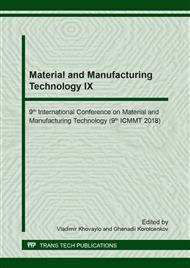p.57
p.62
p.67
p.74
p.80
p.93
p.98
p.105
p.111
Evaluation of Face Milling Operation Parameters on Surface Roughness of Crankcase Housing by Two Level Factorial Design with Center Points
Abstract:
In this study, there are three machining parameters consist of spindle speed, feed rate and depth of cut which were conducted through full factorial with four center points to determine the effect of machining parameters on the surface roughness and verify whether there is curvature in the model for CNC face milling process in an automotive components manufacturer in Thailand. The workpieces used semi-solid die casted ADC12 aluminum alloy crankcase housing which they were performed by the ARES SEIKI model R5630 3-axis CNC vertical machining center and face milling cutter with diameter of 63 millimeters. The surface roughness of face-milled was measured by the surface roughness tester. It was found that the greatest main effect influence to surface roughness was spindle speed, followed by feed rate and depth of cut at significance level of 0.05.
Info:
Periodical:
Pages:
105-110
Citation:
Online since:
September 2018
Price:
Сopyright:
© 2018 Trans Tech Publications Ltd. All Rights Reserved
Share:
Citation:


